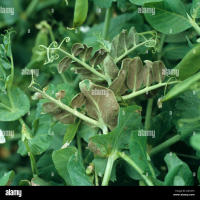Downy mildew of Rhubarb
Peronospora jaapiana
Downy mildew of rhubarb, caused by the oomycete pathogen Peronospora polygoni, is a common fungal disease affecting rhubarb plants. Here's an informative description of downy mildew of rhubarb, including its appearance, identification, and management:
1. Symptoms:
- Leaf Lesions: Initial symptoms include the appearance of yellow to pale green lesions on the upper surface of rhubarb leaves.
- Downy Growth: On the undersides of infected leaves, a characteristic downy growth or mold develops. This downy growth is typically white to grayish in color.
- Lesion Expansion: Lesions may enlarge, coalesce, and lead to extensive damage. Severe infections can result in the distortion and curling of affected leaves.
2. Disease Cycle:
- Infection: The pathogen initiates infection through spores (sporangia), which are produced on infected plant tissues.
- Spore Dispersal: Spores are dispersed by wind, water, or other means, leading to the infection of nearby rhubarb plants.
- Germination: Upon reaching a susceptible host, spores germinate to release zoospores, which then infect new plant tissues, completing the cycle.
- Survival: The pathogen can survive between growing seasons in infected plant debris.
3. Identification:
- Leaf Symptoms: Identification often begins with the observation of yellow lesions on the upper leaf surface and the characteristic downy growth on the undersides of leaves.
- White to Grayish Downy Growth: The color of the downy growth is a key identifier.
- Lesion Patterns: Lesions may exhibit irregular patterns on the leaves.
4. Management:
- Resistant Varieties: If available, consider planting rhubarb varieties that are resistant or less susceptible to downy mildew.
- Fungicide Applications: Fungicides, especially those effective against oomycetes, can be applied preventively or curatively. Application timing is crucial, and a rotation of different fungicide classes is recommended to reduce the risk of resistance development.
- Cultural Practices: Practices such as proper spacing, adequate ventilation, and avoiding excessive irrigation can help create less favorable conditions for disease development.
- Sanitation: Removal and destruction of infected plant debris contribute to reducing the source of inoculum.
5. Importance:
- Economic Impact: Downy mildew of rhubarb caused by Peronospora polygoni can lead to significant yield losses and reduce the quality of rhubarb crops.
- Local Distribution: The disease can occur in regions where rhubarb is cultivated.














